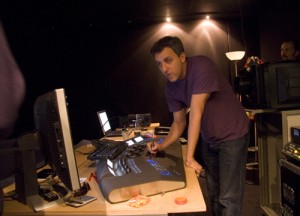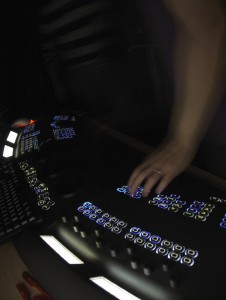James Bond, The Queen and Hannibal Lecter have all been through Framestore CFC’s Digital Lab. We caught up with senior Colourist Asa Shoul, and Executive Producer Jan Hogevold in London to discuss the role of DI in the London film market.
With a staff of over 700, Framestore CFC is one of the largest post houses in London and it has one of the most skilled digital grading organisations in Europe. Formed from the merge of Framestore and the Computer Film Company, Framestore CFC has approached the area of DI from a computer background and not that of a traditional chemical Lab, but as such they have been very quick to adopt new work practices and provide the highest quality DI process. The Computer Film Company was one of the first digital film special effects companies. Founded in London in 1984, CFC developed its own technology of digital film scanning, compositing and output devices.

Framestore CFC uses the the Northlight film scanner. Theo Wade Brown was responsible for the scanner’s physical and mechanical design. CFC was founded by Dr Mike Boudry, who made significant technical contributions to film making he was helped in the early days by Wolfgang Lempp who is now CTO at Filmlight. CFC’s achievements in film have been recognized throughout the industry, and have led to CFC being awarded two Scientific and Technical Academy Awards, in 1995 received by Mike Boudry for innovation.
Initially the company specialised in scanning and recording but as of 1999 the compay pioneered the Digital Intermediate process. Starting with Chicken Run in 2000, Framestore CFC has created digital intermediates for films as diverse as The Constant Gardener, The Queen, Casino Royale, United 93, Cold Mountain, Alien vs Predator, Layer Cake, and Mr Bean’s Holiday.
The company now offers three dedicated grading suites for DI as well as scanning and recording. The divison inputs are based on two Northlight film scanners, and three digital suites are each equiped with digital projection systems and Baselight 8 grading systems. There is also the option of using the companies Spirit 4K, but this is almost only used on TVC work. At the end of the process, Framestore CFC has three Arrilaser film recorders.
Framestore CFC primarily uses the Baselight for its grading and finishing system for film and video, provinding real-time operation at resolutions of up to 4K. All the Framestore CFC systems incorporate FilmLight’s Truelight 3D colour management system, a hardware LUT system for monitor alignment. This enables them to have custom LUTS for various labs in London, as well a different film stocks and screening methods such as projectors and monitors.

Baselight utilises a centralised grade database architecture, supporting enterprise-wide collaborative working and has proven very popular in London. The Mill just also bought a Baselight FOUR colour grading system. The new 2K colour grader will be The Mill’s second Baselight. the Mill uses their Baselight systems for films and TVC work. Framestore CFC has a strong commercials division but in this week’s podcast we speak to two of the principles of Framestore CFCs digital Lab operation about their feature film work. In the podcast they discuss client management, colour timing in general and point to examples from many of their more high profile films such as the Constant Gardener.
One of the interesting aspects of the Framestore CFC pipeline is the Sony Digital Mastering DCI, which means they delivery device independent Cap XYZ files for digital mastering for digital distribution. A film when encrypted can be over 175 gigabyte digital file package, which includes audio, subtitles, and more. The DCI spec is 4:4:4 12 bit XYZ (a superset of RGB colorspace). Framestore delivered film such as Casino Royale as both standard negative (normally up to 3 copies of the Negative) and as a digital file in the DCI format for digital distribution.
Having a solid technical foundation certainly helps the colourists creatively as well. Shoul graded The Queen over two weeks, spent largely in the company of Cinematographer Affonso Beato, with periodic visits from director Stephen Frears. In addition to the smooth blending in of effects shots, Shoul had to work with an unusually high proportion of archive footage – the means by which both the audience and the characters in the film watch some of the story elements unfolding. The quality of the available material varied enormously, and Shoul worked with VFX Supervisor Nelmes, who created mattes for Shoul which looked like the scan lines on a television, which Shoul superimposed over most of the TV screens, and which had the effect of evening out the image quality.
Another important element of Frears’ and Beato’s approach to the material were the different ways in which the two camps – the Royals and the Blairs – were shot. As a visual metaphor for their different sytles, the Blairs’ footage was shot with a handheld Super 16mm camera, while the Royal family were filmed in 35mm, with the camera frequently moving slowly or locked off. This technique works well without belabouring its point, and was complemented in the grade by a slight desaturation of the 35mm footage and a corresponding sharpening of the 16mm material. These are all techniques which the DI process makes readily available.

For the 2006 feature V for Vendetta, colourist Adam Glasman was brought in early by director James McTeigue to help develop the look of the film along with DP Adrian Biddle. We mention this movie, as it will be airing on HBO in high definition in the states in May and will be a great opportunity to view CFC’s work on the feature.
A lot of the creative trial and error was actually done during the creative editorial process as opposed to waiting for the edit to be finalized. In fact, even some of the original on set lighting was left a bit brighter than normal, knowing that the look could be finessed via the DI process in post.
A huge part of the effort was dealing with V’s mask. Imagine a DP’s nightmare of a main character dressed in black with a white mask which needed to maintain detail. On top of this, they needed to somehow show emotion on a fixed, static mask. How does one make this happen? Via grading. At first, Glasman tried drawing relevant shapes on the mask and move them with the tracking system in the grading software. “Unfortunately, the drawn shapes only looked realistic enough on a few occasions,” says Glasman.
So the team looked across the company to Senior Compositing Artist Jonathan Fawkner. Fawkner and a small team built a 3D model in Maya from a scan of the real mask and, using boujou and Matchmover, tracked it onto the character. They then lit the mask, rendered out a grayscale matte in RenderMan, and imported that matte into the grading suite. There, with Fawkner sitting in, colourist Adam Inglis applied corrections through the 3D matte to increase the density and create shadows on the filmed mask.
The advantage of this was a process that eliminated the toing and froing that would have been the inevitable result of doing the VFX aspects of the work separately. “We could have done this in compositing,” says Fawkner, “But we would have had to deliver it for comments, go back and change it, deliver it again, and so forth. Instead, we basically had a client session in which we were able to increase and decrease the contrast in the mask and make it lighter or darker so that it not only matched the rest of the lighting, but it also did its job in telling more of a story and giving V more character.”
